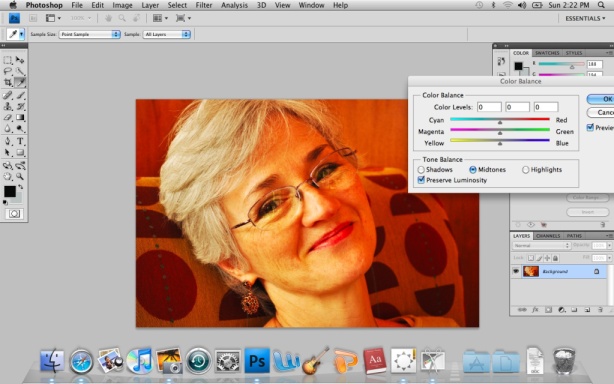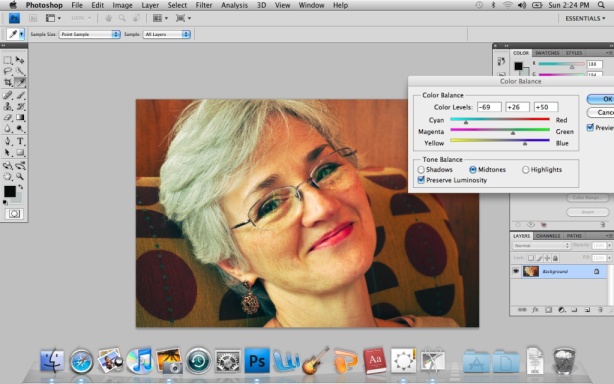You may not have known this, but it’s Embarrassing Story Monday today! Aren’t you excited? On the menu today: a classic tale of love, embarrassment, revenge, and a dueling death. Minus the revenge and dueling death parts.
Overall, our wedding—almost 5 years ago!—went smoothly. It was cheap, which was a plus since we had no money at the time, and a ton of people came together to help out and make it happen—bless your hearts fruit-chopping, church-cleaning members of Eagle Creek!
My husband and I didn’t care enough about the details to really supervise anything— we were just interested in the soon-to-be-had marital freedoms. Of the bedroom persuasion. Just kidding! Or not. Hey, it had been a long courtship, OK? And hormones were raging. Raging, I tell you.
Here we are, looking quite calm—but raging inside.
Anyway, to this day I’m surprised it all actually happened. I don’t remember organizing half the things that went down. I was 22 (21 during most of the planning) and just couldn’t bring myself to care about flowers, or colors, or logistics, or my hairdressing arrangements (hence the “plastered hair” look), or really anything except tying the actual knot. This lack of focus on my part led to an interesting situation during the ceremony.
We had 4 Scripture readings, 1 for each of my current roommates. For your edification and to set the record straight for posterity, here is the reading from Hosea that was supposed to happen. It’s not your typical wedding reading, but to this day those last couple verses give me the chills (Hosea 2:14-23):
Therefore I am now going to allure her; I will lead her into the desert and speak tenderly to her. There I will give her back her vineyards, and will make the Valley of Achor a door of hope. There she will sing as in the days of her youth, as in the day she came up out of Egypt.
“In that day,” declares the LORD, “you will call me ‘my husband’; you will no longer call me ‘my master. ‘ I will remove the names of the Baals from her lips; no longer will their names be invoked. In that day I will make a covenant for them with the beasts of the field and the birds of the air and the creatures that move along the ground. Bow and sword and battle I will abolish from the land, so that all may lie down in safety.
I will betroth you to me forever; I will betroth you in righteousness and justice, in love and compassion. I will betroth you in faithfulness, and you will acknowledge the LORD.
“In that day I will respond,” declares the LORD—”I will respond to the skies, and they will respond to the earth; and the earth will respond to the grain, the new wine and oil, and they will respond to Jezreel.
I will plant her for myself in the land; I will show my love to the one I called ‘Not my loved one. ‘ I will say to those called ‘Not my people,’ ‘You are my people’; and they will say, ‘You are my God.’
We thought it was beautiful because it shows that marriage is a reflection of God’s relationship with his people—God wants to be a “husband” instead of a “master”, and gives them a place of peace and safety where they are reconciled to him perfectly, and where they sing for joy. Aaaaah.
Alackaday, there was a hefty miscommunication about the stopping point in the above passage—and yes, I take full responsibility since my mind was occupied by “other things”. My roommate—bless her heart—sailed right past the end of chapter 2, diving headlong and with no regrets into the following:
The LORD said to me, “Go, show your love to your wife again, though she is loved by another and is an adulteress. Love her as the LORD loves the Israelites, though they turn to other gods and love the sacred raisin cakes.” So I bought her for fifteen shekels of silver and about a homer and a lethek of barley. Then I told her, “You are to live with me many days; you must not be a prostitute or be intimate with any man, and I will live with you.” For the Israelites will live many days without king or prince, without sacrifice or sacred stones, without ephod or idol. Afterward the Israelites will return and seek the LORD their God and David their king. They will come trembling to the LORD and to his blessings in the last days.
My extended family cackled in the pews. My raucous male cousins cackled in the pews.
My brain started overheating. The flush that comes when a woman is called “prostitute” to her face spread across me like the Red Sea. I briefly considered wrenching the microphone from my uncle (our pastor) and sobbing “I swear I’m not a prostitute! I’ve remained pure for my wedding day despite the raging hormones! Anyway, how can I be an adulteress if I’m not even married, guys! Come on, I don’t even like the sacred raisin cakes!” Plus, I wanted to ask if anyone in attendance knew what a homer or lethek of barley was, and where one could obtain such a thing in modern times.
I like to remember the ordeal as the “whore of Babylon incident”. And so does my extended family.
I’ve finally gotten to the point where I can laugh uproariously crack a smile at this memory. Aren’t you glad I’m making progress? I have a special drawer just for my therapy bills.
On a side note, those raisin cakes must have been something all right.
Happy Monday, one and all!













